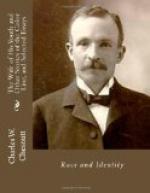Arrived at the main entrance, Mr. Clayton directed the carriage to wait, and entered the station with Jack. The Union Depot at Groveland was an immense oblong structure, covering a dozen parallel tracks and furnishing terminal passenger facilities for half a dozen railroads. The tracks ran east and west, and the depot was entered from the south, at about the middle of the building. On either side of the entrance, the waiting-rooms, refreshment rooms, baggage and express departments, and other administrative offices, extended in a row for the entire length of the building; and beyond them and parallel with them stretched a long open space, separated from the tracks by an iron fence or grille. There were two entrance gates in the fence, at which tickets must be shown before access could be had to trains, and two other gates, by which arriving passengers came out.
Mr. Clayton looked at the blackboard on the wall underneath the station clock, and observed that the 7.30 train from Washington was five minutes late. Accompanied by Jack he walked up and down the platform until the train, with the usual accompaniment of panting steam and clanging bell and rumbling trucks, pulled into the station, and drew up on the third or fourth track from the iron railing. Mr. Clayton stationed himself at the gate nearest the rear end of the train, reasoning that the Congressman would ride in a parlor car, and would naturally come out by the gate nearest the point at which he left the train.
“You ’d better go and stand by the other gate, Jack,” he said to his companion, “and stop him if he goes out that way.”
The train was well filled and a stream of passengers poured through. Mr. Clayton scanned the crowd carefully as they approached the gate, and scrutinized each passenger as he came through, without seeing any one that met the description of Congressman Brown, as given by Sadler, or any one that could in his opinion be the gentleman for whom he was looking. When the last one had passed through he was left to the conclusion that his expected guest had gone out by the other gate. Mr. Clayton hastened thither.
“Did n’t he come out this way, Jack?” he asked.
“No, sir,” replied the young man, “I have n’t seen him.”
“That ’s strange,” mused Mr. Clayton, somewhat anxiously. “He would hardly fail to come without giving us notice. Surely we must have missed him. We ’d better look around a little. You go that way and I ’ll go this.”
Mr. Clayton turned and walked several rods along the platform to the men’s waiting-room, and standing near the door glanced around to see if he could find the object of his search. The only colored person in the room was a stout and very black man, wearing a broadcloth suit and a silk hat, and seated a short distance from the door. On the seat by his side stood a couple of valises. On one of them, the one nearest him, on which his arm rested, was written, in white letters, plainly legible,——




